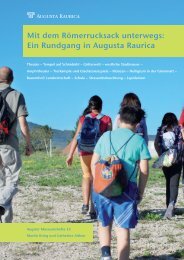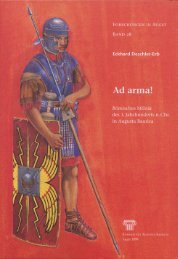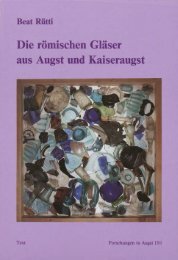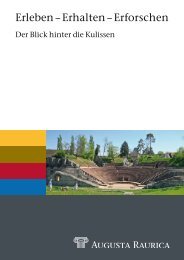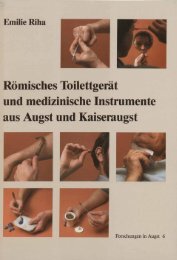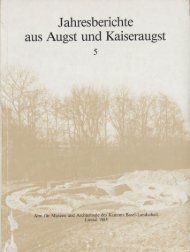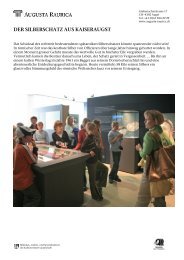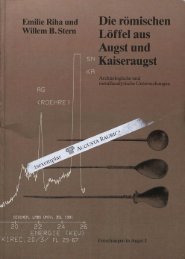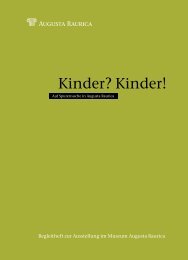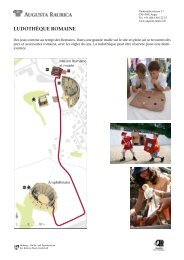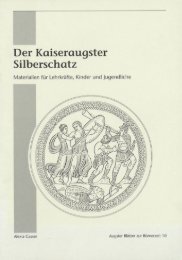Götter und Lararien aus Augusta Raurica
Götter und Lararien aus Augusta Raurica
Götter und Lararien aus Augusta Raurica
Sie wollen auch ein ePaper? Erhöhen Sie die Reichweite Ihrer Titel.
YUMPU macht aus Druck-PDFs automatisch weboptimierte ePaper, die Google liebt.
Summary<br />
Within the last two h<strong>und</strong>red years, aro<strong>und</strong> 450 figurai<br />
bronzes have come to light in the area of Roman<br />
settlement in Augst and Kaiseraugst. The individual<br />
objects were published in 1977 and 1994 in two<br />
separate catalogue volumes; the present study draws<br />
together some general points on the basis of this<br />
material.<br />
Although a series of metalworking workshops are<br />
known in larger and smaller settlements in the Roman<br />
Empire, it is practically impossible to attribute finished<br />
products to them with any certainty. This is mainly<br />
due to the technique of manufacturing for bronzes.<br />
These were cast using the lost wax technique, but the<br />
wax models employed for this were often made using<br />
negative moulds which could be re-used in various<br />
combinations. It was also possible to make negative<br />
moulds from finished objects so that in some circumstances<br />
the same bronzes could be reproduced far<br />
away from the original place of production.<br />
Despite these unfavourable preconditions, groups of<br />
bronzes which correspond in terms of size, type and<br />
stylistic characteristics may give indications of possible<br />
workshop circles. In a few cases these can be defined<br />
geographically. Thus two types of mixing rods and<br />
knife handles of the 1st century AD are concentrated in<br />
northern Switzerland and the adjoining region to the<br />
west. The centres of production of a type of bucket<br />
from the 2nd/3rd century, of which the occasional<br />
attachments have survived in our area, are to be sought<br />
in northern Italy. It is also possible to identify related<br />
workshops for several types of statuettes of divinities.<br />
The dating of Roman bronzes of average quality<br />
from both Italy and the provinces remains a particular<br />
problem. A comparison of several statuettes dated by<br />
their finds context to the 1st century makes probable<br />
that statuettes were also manufactured north of the<br />
Alps from the middle of the 1st century at the latest.<br />
The findspot within the area of the Roman settlement<br />
is known for about three quarters of the figurai<br />
bronzes from <strong>Augusta</strong> <strong>Raurica</strong>. An obvious concern<br />
was to see whether conclusions could be drawn from<br />
the distribution of these objects (part II). The vertical<br />
distribution shows that 1st century layers produced<br />
mainly small, everyday objects with a limited period of<br />
use, together with militaria. Few finds complexes with<br />
figurai bronzes have survived from the mid-imperial<br />
period. The fact that other categories of finds are also<br />
poorly represented in this period may be connected<br />
with a different method of building. The majority of<br />
surviving statuettes derives from finds complexes of<br />
the later imperial period. Apparently these were kept<br />
until the end of the period of Roman settlement<br />
bec<strong>aus</strong>e they were valuable and religiously significant<br />
possessions.<br />
The horizontal distribution of the bronzes proved to<br />
be less informative. Not surprisingly, public buildings<br />
were cleared more systematically than residential and<br />
industrial areas. What is remarkable, however, is that<br />
the character and quantity of bronzes surviving in wellto-do<br />
houses is hardly distinguishable from those<br />
fo<strong>und</strong> in the more modest craftsmen's neighbourhoods.<br />
It seems that too many external factors played<br />
a role here for conclusions to be reached from the<br />
available material about social structure and accoutrements.<br />
As the most important and varied group of bronzes<br />
from <strong>Augusta</strong> <strong>Raurica</strong>, the statuettes of divinities<br />
were examined as a group (part III). Their findspots<br />
are for the most part in the residential and industrial<br />
neighbourhoods. It is therefore probable that even<br />
statuettes which were fo<strong>und</strong> singly once stood in<br />
domestic shrines. As well as statuettes, a lararium<br />
inventory could include incense cups and pottery<br />
vessels with snake motives. Among the evidence for<br />
cults known in Augst and Kaiseraugst are, besides<br />
bronze statuettes, votive inscriptions and stone sculptures.<br />
Unfortunately, of the inscriptions, which could<br />
best give information on religious life, only a few fragments<br />
survive. Statuettes of divinities on top of small<br />
offerings boxes, of which there is an example from<br />
Kaiseraugst, are in evidence above all in eastern Gaul,<br />
mainly in domestic spheres (excursus II).<br />
Part IV deals with the function and use of statuettes<br />
of divinities in broad terms. Under investigation was<br />
the composition of groups of statuettes which intentionally<br />
or by chance were buried together. The starting<br />
point was six groups of finds from the urban area<br />
of <strong>Augusta</strong> <strong>Raurica</strong> which wholly or partially comprise<br />
statuettes. As many groups of statuettes as possible<br />
from Italy and the provinces were studied.<br />
The numerous finds from the towns by Vesuvius<br />
which were buried in situ bec<strong>aus</strong>e of the volcanic eruption<br />
give a good picture of the contents and variety of<br />
domestic shrines in Campania. Outside Italy, the contents<br />
of numerous lararia have survived, above all in<br />
Gaul and Germany. These are often not fo<strong>und</strong> in place<br />
inside a house, however, but rather in so-called precautionary<br />
caches («Angstdepots») which were established<br />
in a time of danger in order to keep precious<br />
possessions safe. Statuettes from lararia have sometimes<br />
also fo<strong>und</strong> their way into stashes of booty or<br />
of metal for recycling. The contents of lararia in the<br />
provinces largely correspond to their Italian model<br />
although the actual house gods, the lares, appear less<br />
frequently. The choice of statuettes seems to have<br />
depended entirely on personal preference in that<br />
statuettes of different sizes and quality, both treasured<br />
heirlooms and contemporary pieces could stand in the<br />
same lararium. A general comparison shows that<br />
especially varied compositions of lararia have survived<br />
in <strong>Augusta</strong> <strong>Raurica</strong>.<br />
The same statuettes that stand in lararia could also<br />
be consecrated in public shrines. Most evidence for



